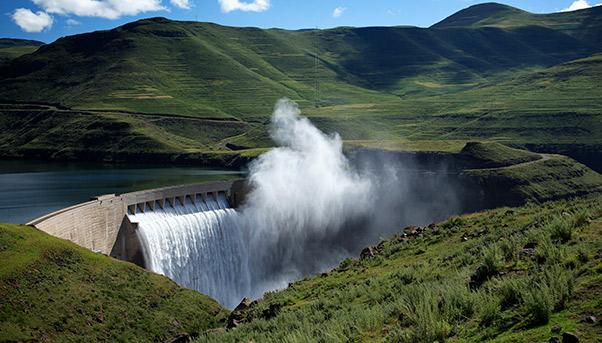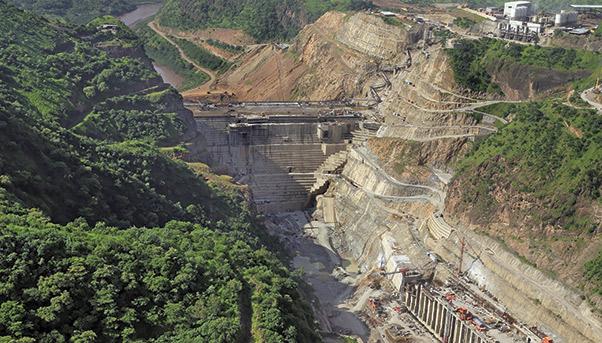
Humankind’s challenge to nature is a wall built against the power of a river. A barrier that changes the course of the water, alters the landscape and transforms a natural resource into a precious asset for development - as much for agriculture as for the supply of energy.
That is the role of the 50,000 big dams in the world, 8,200 of which have hydroelectric plants, according to the International Commission on Large Dams, the international organization that manages a register of large dams. They are public works that are essential for growth and have enjoyed astonishing progress in the last century in terms of complexity and technical achievement, enough to bring to life even the most visionary projects.
From Ethiopia’s big dams to the giants in China to the hydroelectric plants that are favoring the development of countries in South America, the sector is always producing more clean energy and contributing in a significant way to the avoidance of additional air pollution that would otherwise be produced by new plants using fossil fuels like coal. It is a role that was not conceived yesterday but far back in time when people studied ways to take advantage of the waters of a river to improve farming to sustain themselves.
Energy for the World: why do we build dams
The importance of dams does not reside in the latest engineering achievements applied to the construction of ambitious yet complex projects, but in their ability to produce cheap, clean and abundant energy from a renewable resource like water.
Hydroelectricity is the most widely used technology to produce energy from a renewable resource, according to the International Energy Agency, which belongs to the Organisation for Economic Co-operation and Development (OECD). Total installed production capacity in the world is 1,000 gigawatts (GW), equal to Europe’s entire capacity from all energy sources. In the last five years, 30 GW of new power has been installed every year, mostly in Africa and Latin America. It is a big development that does not seem destined to slow down, with the agency expecting hydropower to double its installed capacity by 2050, helping avoid three billion tonnes of additional CO2 emissions every year that would otherwise come from fossil fuels. And this is the real mission of the sector: to build big dams that have an enormous impact in terms of energy production while having a minimal impact on the environment. It is a delicate balance to be played in the coming years.
The Big Dams built in Africa
Just like Legadadi, the dam built in Ethiopia between 1964 and 1970 by Salini Impregilo, Kariba serves as an example of taking advantage of water for energy, a precious and generous asset made available by Africa’s giant rivers.
A player in the economic development of many countries on the continent for the last 50 years, Salini Impregilo made its skills and experience as a global leader in the water segment available for the construction of some of the most ambitious projects. The Katse Dam, inaugurated in May 1977 in Lesotho, was for a long time the tallest in Africa at 185 metres with a reservoir of 2.32 million cubic metres. But one of the countries where technical excellence has married the best with the territory, bringing to life hydroelectric plants with a decisive impact on the region, is Ethiopia.
The Gibe I and Gibe II dams – along with the Beles plant - satisfy 50% of the energy needs of the country. Gibe III on the Omo River, recently completed by Salini Impregilo, will increase national energy production by 85%. It is will rise by a further 270% with the eventual inauguration of the Grand Ethiopian Renaissance Dam (GERD) built on the Blue Nile by Salini Impregilo to become the biggest in Africa and among the world’s top 10.
These big dams have a huge impact on the development of Ethiopia, which has seen its gross domestic product grow by an annual 10% for the past 10 years. GERD is expected by experts to produce enough electricity to add to the equivalent of €1 billion to its trade balance thanks to its sale to countries like Sudan, Djibouti, South Sudan and Yemen.

The Chinese Race
In light of the enormous demand for energy in the country, China is definitely one of the points of reference for the construction of big dams. Before it is surpassed by Tajikistan’s Rogun dam that – at 335 metres – will be the tallest in the world, Jinping-I enjoys the title at 305 metres. Built on the Yalong River in the Sichuan region, its construction began in 2005 and ended in 2014. The history of the dam dates back to the 1960s when the Sichuan and Shanghai Design Institute in collaboration with the Ministry of Water Resources put together a team to design the project. The aim was to guarantee a supply of energy to support the industrialization and urbanization of the region, an objective that – despite all the years of delays – Jinping-I is respecting thanks to its production capacity of 3,600 MW.
But China’s march towards the construction of big dams began with a project that set a precedent for hydroelectric plants in the country with the transmission of technical skills to local workers. It is the Ertan dam, built by Salini Impregilo between 1991 and 1999 on the Yalong River, a tributary of the Yangtze. Standing 240 metres in height, Ertan is still one of the tallest in the world and, as much for its complexity as for its installed production capacity of 3,300 MW, it set the standard for the construction of future dams in China.
History of Dams
In 3,000 B.C., the residents of the city of Jawa in Jordan built a system of cisterns carved in the ground that were filled with water by means of a sluice gate that blocked the flow of a river.
Primitive and rudimentary, this is one of the first examples of a dam.
From then on, all great civilizations have struggled to harness the flow of rivers, from the Egyptians to the Babylonians; from the Persians to the Greeks; from the Romans to the Byzantines. With the passage of centuries, they worked to perfect the engineering, giving birth to always more complex and grandiose infrastructure projects able of enduring the ravages of time.
In Spain, there are still some working dams built between 1500 and 1600. One example is the Elche, built in 1655. Then there is that of Alicante from 1594 or Almansa, built in 1584. In each case there have obviously been repairs and maintenance done but always in respect of the original structure.
It is a journey that led up to the early 20th century with the Assuan dam in Egypt, still the biggest on the Nile, built by the British and inaugurated in 1902. In subsequent years, there were a number of interventions done to increase its height until 1946 when it was decided to build a new dam upstream. It was completed in 1970. These are the decades that witnessed the development of Africa’s infrastructure, with works that have marked the history of the continent.
Kariba, the biggest dam on the Zambezi River between Zambia and Zimbabwe, is one of those projects. Built between 1955 and 1959, the dam was for years among the tallest in the world at a height of 128 metres and a crest length of 579 metres. It was able to produce electricity for both Zambia and Zimbabwe. Another record was set by the artificial lake created by the dam that extends for 280 kilometres and holds 180 cubic kilometres.


